You’ve probably missed countless dishwasher cycles because you simply forgot they were running. Setting up automated notifications transforms this daily frustration into seamless convenience, but most people don’t realize how straightforward the process can be with the right components. Whether you’re using a basic power monitoring switch or integrating with advanced home automation systems, there’s a specific sequence that determines whether your setup works flawlessly or becomes another tech headache.
Understanding Home Connect Dishwasher Integration Options
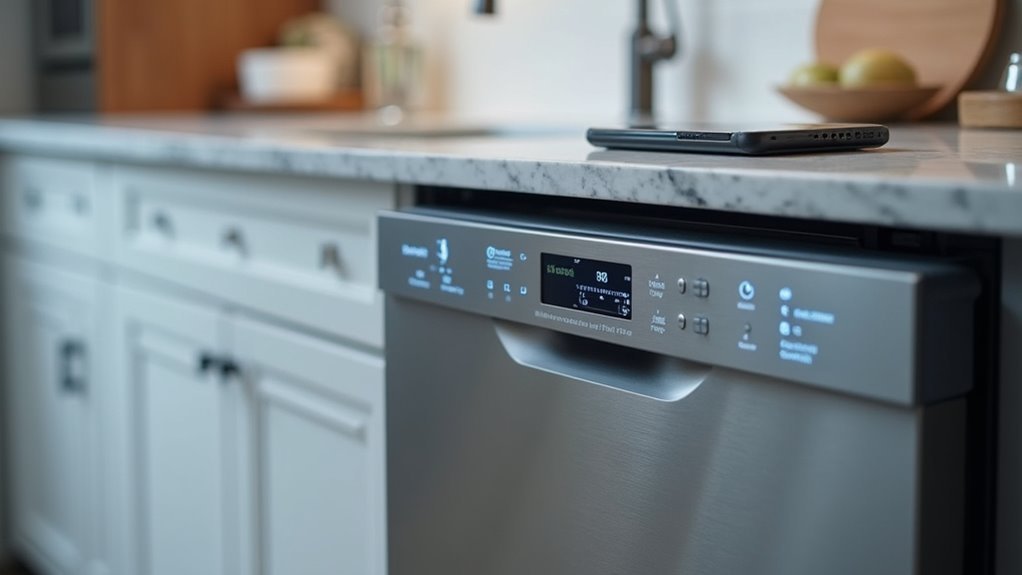
When you’re setting up dishwasher notifications, you’ll need to understand how Home Connect integration works with your smart home ecosystem.
Home Connect bridges your dishwasher with various smart home platforms, enabling seamless remote monitoring and control through dedicated apps.
Your dishwasher compatibility depends on the brand you own. Home Connect supports major manufacturers including Bosch, Siemens, Neff, Gaggenau, and Thermador.
Home Connect works with major brands like Bosch, Siemens, Neff, Gaggenau, and Thermador for seamless smart home integration.
This broad compatibility guarantees you can integrate multiple smart appliances from these brands into one unified system.
The integration allows you to receive automated notifications for essential dishwasher states like cycle starts, completions, and maintenance alerts for low salt or rinse aid.
You’ll also gain access to historical data tracking your usage patterns, helping you optimize efficiency and understand your dishwashing habits over time.
Essential Hardware Components for Smart Dishwasher Monitoring
While your dishwasher’s built-in smart features provide basic connectivity, you’ll need additional hardware components to create an extensive monitoring system that tracks every aspect of your appliance’s operation.
Start with a Samsung Multipurpose sensor ($20) or Z-Wave Door/Window Sensor like the Fibaro FGK101 to monitor door status accurately. These sensors require ideal placement for reliable operation.
Smart plugs with energy monitoring capabilities provide real-time power consumption data, helping you track your smart dishwasher’s operational cycles.
For visual notifications, integrate LED strips or RGB controllers that create colored alerts indicating current status.
Consider combining tilt, acceleration, and temperature sensors for thorough cycle monitoring and maintenance alerts, preventing potential operational issues before they occur.
Setting Up Z-Wave Power Monitoring for Dishwasher State Detection
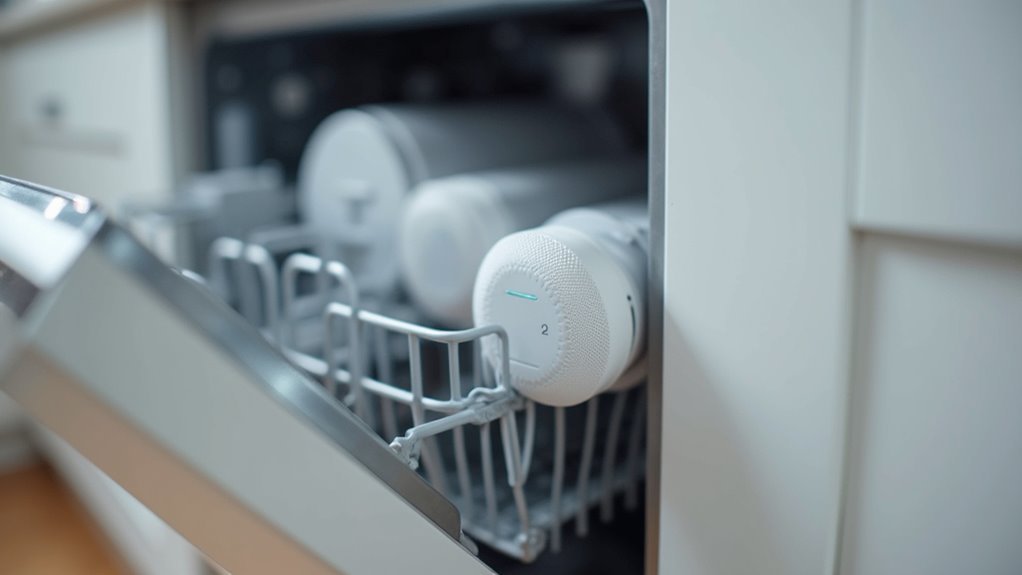
You’ll need to choose the right Z-Wave switch that can handle your dishwasher’s power requirements and provide accurate monitoring capabilities.
The Aeotec Smart Switch works well for this purpose since it supports up to 10 amps and can detect the power consumption patterns that indicate different dishwasher states.
Once you’ve selected your hardware, you’ll configure the power monitoring settings in your home automation platform to translate those power readings into meaningful state information.
Z-Wave Switch Selection
Three key factors determine the success of your Z-Wave dishwasher monitoring setup: power rating compatibility, accurate state detection capabilities, and proper installation positioning.
You’ll need a Z-Wave switch that handles your dishwasher’s power requirements—the Aeotec Smart Switch 6 supports up to 10 amps, making it ideal for most dishwashers.
Your chosen switch must accurately monitor power consumption changes to detect operational states like “Running” through significant power draw increases.
Position your Z-Wave switch where it won’t obstruct dishwasher operation while maintaining accurate power monitoring.
Configure proper polling settings to guarantee timely power level updates, which enhances notification responsiveness.
This foundation enables reliable automation rules that track the “Clean” state by detecting power consumption drops after the drying cycle completes.
Power Monitoring Configuration
Once your Z-Wave switch is installed, configure the power monitoring settings in your home automation system’s `configuration.yaml` file to track your dishwasher’s operational states.
You’ll need to adjust polling settings to accurately capture power usage fluctuations as your dishwasher shifts between cleaning, drying, and idle modes.
Your dishwasher typically draws around 600W at 115V during active operation, making it easy to distinguish between running and standby states.
Set up template sensors to create clear indicators for different operational phases and door status.
- Monitor power draw patterns to identify cleaning cycles versus drying phases
- Configure automation rules that trigger notifications when cycles complete
- Set up state shift conditions based on power fluctuations for accurate tracking
Installing Door and Window Sensors for Dishwasher Access Tracking
While traditional dishwasher monitoring relies on sound cues or manual checking, installing a door or window contact sensor provides precise, automated tracking of your appliance’s access status.
You’ll want to use a sensor like the Fibaro FGK101, which detects when your dishwasher door opens or closes. Position it on the dishwasher’s side to guarantee accurate registration without obstructing operation.
Configure the sensor as a garage door sensor, enabling it to determine open/closed status through a tilt mechanism. Connect it to Home Assistant to create automations that send real-time notifications when someone accesses your dishwasher.
Strategic placement also allows temperature monitoring during drying cycles, providing vital data for accurate cycle status tracking and thorough appliance monitoring.
Configuring Home Assistant for Dishwasher Automation
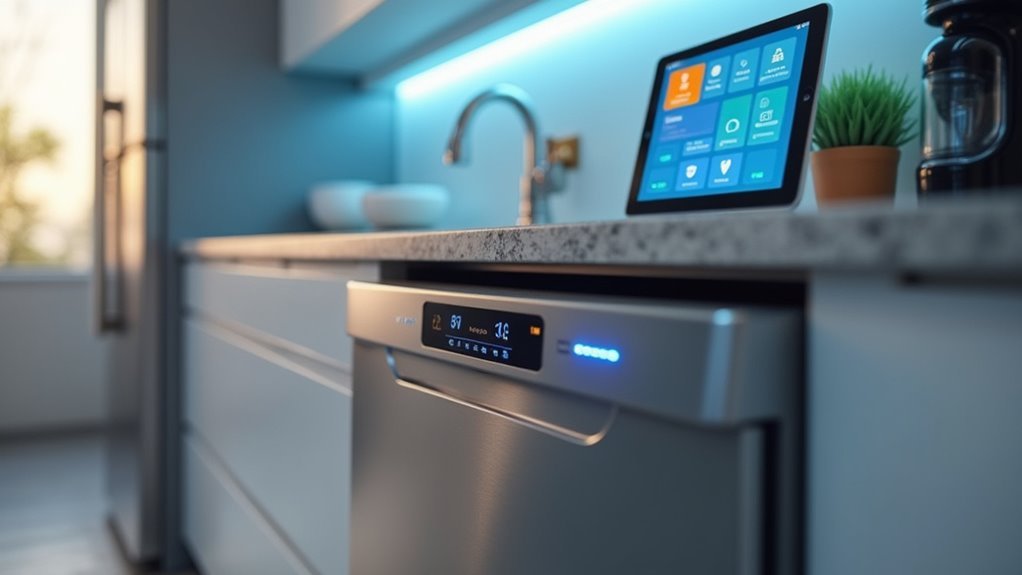
Now that you’ve installed your door and window sensors, you’ll need to configure Home Assistant to monitor your dishwasher’s power consumption and create intelligent state changes.
You’ll set up power monitoring through Z-Wave switches to track energy usage patterns, then establish sensor integration methods that combine door status with power draw data.
These components work together to create accurate state change rules that’ll automatically detect when your dishwasher is dirty, running, drying, or clean.
Power Monitoring Setup
Setting up power monitoring for your dishwasher requires a Z-Wave power monitor or smart switch that can handle your appliance’s electrical load—typically around 600W for standard dishwashers.
You’ll need to configure your `configuration.yaml` file to include the Z-Wave device, ensuring it reports power levels and status changes during operation.
Create automation rules that trigger notifications based on power fluctuations, indicating states like “Running,” “Drying,” and “Clean.”
Template sensors can track your dishwasher door’s status for better state management.
- Install a Z-Wave power monitor rated for at least 600W capacity
- Configure automation rules to detect power draw patterns and send notifications
- Adjust Z-Wave polling settings regularly for timely updates and responsive monitoring
State Transition Rules
Once you’ve established power monitoring, you’ll configure state change rules that define how your dishwasher moves between four distinct phases: Dirty, Running, Drying, and Clean.
These automation rules use power draw measurements to determine shifts between each state of the dishwasher. When power consumption exceeds your threshold, the system switches from “Dirty” to “Running.”
As power drops but remains slightly elevated, it indicates the “Drying” phase. Finally, when power returns to baseline levels, the state changes to “Clean.”
You’ll create these shifts using Home Assistant’s automation editor, setting specific wattage triggers for each phase. This systematic approach guarantees accurate tracking of your dishwasher’s complete cycle, enabling reliable notifications when dishes are ready.
Sensor Integration Methods
Effective automation relies on combining multiple sensor types to capture your dishwasher’s complete operational picture.
You’ll need to implement strategic sensor integration methods that work together seamlessly. Start by attaching a tilt or door/window contact sensor to detect when your dishwasher door opens or closes. This tracks cycle completion accurately.
Next, install a Z-Wave or Zigbee power monitoring switch to measure energy consumption patterns that indicate running, drying, or clean states.
Essential sensor integration methods include:
- Door sensors – Track physical door position for cycle status verification
- Power monitoring switches – Detect operational states through energy consumption patterns
- Template sensors – Create intuitive dashboard displays with customizable visual indicators
Configure Z-Wave polling settings in your `configuration.yaml` file to enhance power reporting responsiveness for real-time dishwasher monitoring.
Creating Virtual Switches for Dishwasher State Management
Virtual switches serve as the foundation for intelligent dishwasher monitoring, acting as digital representations of your appliance’s operational states within your home automation system.
Create a virtual switch named “Dishwasher” to track your appliance’s complete cycle. Configure it to activate when a cycle finishes and deactivate when you empty the dishwasher.
Use power monitoring to detect when your dishwasher’s running by tracking power draw fluctuations during washing and drying phases. This alters your virtual switch to an “isRunning” state automatically.
Integrate the virtual switch with platforms like Home Assistant for seamless automation.
Set up rules that trigger notifications when cycles complete, ensuring household members receive timely updates.
Include manual intervention triggers, such as door sensors, to accurately reset the virtual switch’s state and confirm your dishes are truly clean.
Programming Automation Logic for Cycle Detection
After establishing your virtual switches, you’ll need to create intelligent automation logic that accurately distinguishes between your dishwasher’s operational phases. The key is monitoring power consumption patterns to identify when your machine shifts from washing to drying, then finally to the clean state.
Your automation should track significant power drops that indicate cycle completion. However, implement a delay mechanism to prevent false triggers during normal power fluctuations. This is particularly important when running your dishwasher at night, as voltage variations can occur.
- Monitor power levels for sustained drops below threshold values to confirm cycle completion
- Combine vibration sensor data with temperature readings for more accurate state detection
- Set appropriate delay timers to filter out temporary power spikes and guarantee reliable cycle identification
Establishing Notification Triggers and Conditions
You’ll need to establish specific triggers and conditions that determine when your dishwasher sends notifications to avoid constant alerts.
Start by monitoring power levels to detect when cycles begin and end, then create time-based rules that prevent notifications during sleeping hours or other inconvenient times.
Consider adding user presence detection so you’re only alerted when you’re actually home to respond to the dishwasher’s status updates.
Power Level Monitoring
Since dishwashers consume different amounts of electricity during various operational phases, power level monitoring becomes the foundation for creating accurate notification triggers.
Z-Wave power switches track your dishwasher’s power draw, revealing whether it’s running, drying, or finished. You’ll notice power drops when shifting from washing to drying cycles, while consistently low levels indicate clean dishes ready for unloading.
- Set threshold-based automation rules that trigger notifications when power consumption drops below specific levels, signaling cycle completion
- Monitor device logs regularly to identify your dishwasher’s unique power patterns and optimize trigger accuracy
- Adjust Z-Wave polling settings to improve responsiveness and guarantee real-time power level reporting for reliable notifications
This power level monitoring approach guarantees you’re notified precisely when your dishwasher finishes its cleaning cycle.
Time-Based Alert Rules
While power monitoring detects when your dishwasher completes its cycle, time-based alert rules determine exactly when and how you’ll receive those notifications.
Set your alerts to operate only between 8:30 AM and 10:30 PM to avoid disturbances during sleeping hours. You’ll need to configure conditions that check if you’re home before triggering notifications, ensuring alerts aren’t sent when no one’s around to see them.
Add a delay mechanism to prevent immediate alerts after cycle completion, creating a buffer period before notifications fire.
Your time-based alert rules should also check when previous notifications were sent to avoid redundancy.
Set up Notify Groups to target specific household members based on their presence, customizing who receives dishwasher alerts depending on who’s actually home.
User Presence Detection
Building on those time-based rules, your smart home system needs to accurately detect who’s actually present before sending dishwasher notifications.
User presence detection guarantees you’re not bombarded with alerts when you’re away from home, making your automation truly intelligent.
Home Assistant’s device trackers and presence sensors work together to identify which family members are currently home.
You can configure your dishwasher notifications to target only present individuals using Notify Group services, creating personalized alert distribution.
- Configure device trackers to monitor smartphones or presence sensors for accurate detection
- Set up delay mechanisms to prevent immediate notifications when someone arrives home
- Use Notify Group services to send targeted alerts only to people currently present
This targeted approach eliminates unnecessary notifications and guarantees relevant household members receive timely dishwasher updates.
Customizing Alert Preferences for Different Household Members
How do you guarantee dishwasher notifications reach the right people at the right times without disrupting your household’s rhythm? Start by creating a “Notify Group” in your automation system that designates specific alert preferences for each family member based on their routines and availability.
| Household Member | Time Restrictions | Alert Details |
|---|---|---|
| Parents | 8:30 AM – 10:30 PM | Full status updates |
| Teenagers | 9:00 AM – 11:00 PM | Simple reminders only |
| Night Shift Worker | 2:00 PM – 6:00 AM | Silent notifications |
When customizing alert preferences, utilize service templates that adapt notifications based on who’s present at home. Implement delay mechanisms when someone arrives, preventing immediate alerts. Customize messages with specific details like cleanliness status and readiness to be emptied, ensuring each family member receives relevant, personalized updates.
Integrating Temperature and Vibration Sensors for Accurate Monitoring
Since dishwasher cycles can vary considerably in duration and intensity, combining temperature and vibration sensors creates the most reliable monitoring system for your smart home setup.
Temperature sensors detect when the drying cycle completes by monitoring temperature drops, while vibration sensors track the machine’s operational activity and door status through tilt detection.
The Samsung Multipurpose sensor offers an affordable $20 solution that handles both temperature and vibration monitoring effectively.
You’ll need to place these sensors strategically where they won’t interfere with your dishwasher’s operation but can still accurately measure the necessary parameters.
- Install tilt sensors on the door to detect open/closed status automatically
- Position temperature sensors to monitor drying cycle completion accurately
- Create virtual switches that combine sensor data for real-time cycle notifications
Testing and Calibrating Your Dishwasher Notification System
After installing your sensors, you’ll need to verify they’re working correctly before relying on automated notifications. Start by running a complete dishwasher cycle while monitoring your virtual switch and sensor readings. When the dishwasher is turned on, track how power consumption changes throughout different phases.
| Test Phase | Expected Behavior | Verification Method |
|---|---|---|
| Washing | High power draw | Check power sensor readings |
| Drying | Lower power levels | Monitor temperature sensor |
| Clean/Complete | Minimal power usage | Confirm virtual switch activation |
Open and close the door multiple times to ascertain your garage door sensor configuration accurately detects door status. Calibrate power thresholds based on your dishwasher’s specific consumption patterns. Test notifications by simulating various states to guarantee real-time alerts function properly across all cycle phases.
Troubleshooting Common Setup Issues and Sensor Placement
Even with proper installation, your dishwasher notification system may encounter operational hiccups that require systematic troubleshooting. The most common culprits involve sensor placement and configuration errors that prevent accurate cycle detection.
Troubleshooting dishwasher notification systems requires methodical diagnosis of sensor placement and configuration issues that disrupt cycle detection accuracy.
When addressing sensor placement issues, verify your Samsung Multipurpose sensor can measure temperature from the drying cycle without obstruction. Position the tilt sensor firmly on the dishwasher’s side to register door status accurately.
You’ll need to test different locations through trial and error until you find the best spot.
- Configure your sensor as a garage door sensor to enable proper cycle tracking
- Monitor power draw readings regularly to identify inconsistencies in appliance state reporting
- Confirm sensors don’t interfere with normal dishwasher operation while maintaining detection effectiveness
Advanced Notification Options With Voice Assistants and Smart Lighting
Once you’ve mastered the basics of sensor setup and troubleshooting, you can expand your dishwasher notification system with voice assistants and smart lighting for a more sophisticated home automation experience.
Integrate Amazon Alexa or Google Assistant to enable hands-free notifications. Configure your voice assistants to announce dishwasher status through voice announcements or automated routines, ensuring you’ll hear updates throughout your home.
Smart lighting adds visual confirmation to your notification system. Program Philips Hue bulbs to change colors or flash when your dishwasher completes its cycle. This creates an intuitive alert that’s visible from anywhere in the room.
Advanced users can leverage Home Assistant to create complex notification rules based on your presence, time of day, and specific dishwasher states, maximizing both functionality and convenience.
Optimizing Performance and Managing Power Consumption Alerts
While visual and voice notifications keep you informed about your dishwasher’s cycles, monitoring its power consumption and performance metrics guarantees your appliance operates effectively and safely.
Z-Wave power monitoring tracks energy consumption and verifies your dishwasher operates within safe limits. You’ll receive alerts when your dishwasher has finished running while maintaining peak energy efficiency.
Z-Wave monitoring ensures your dishwasher runs safely and efficiently while alerting you when cycles complete.
Set up notifications for low salt and rinse aid levels to preserve cleaning performance. Implement delay mechanisms in automation rules to prevent false alerts during power fluctuations.
Check your dishwasher’s power draw regularly, especially with older models that might exceed smart switch capabilities.
- Monitor power usage patterns to schedule energy-efficient wash cycles during off-peak hours
- Set maintenance reminders for salt and rinse aid refills to maintain peak cleaning results
- Configure delayed notifications to avoid false alerts from temporary power fluctuations
Frequently Asked Questions
How to Set a Dishwasher Timer?
Download the Home Connect app and connect your dishwasher securely. You’ll use the app’s scheduling feature to select your preferred start time, choose your washing program, and confirm the cycle to activate the timer.
How to Stop a Dishwasher in Between?
Open your dishwasher door to automatically pause the cycle. If it doesn’t stop, press the “Cancel” or “Stop” button. Be cautious of water spillage when opening mid-cycle.
How to Start a Dishwasher Without a Start Button?
You can start your dishwasher by using a mobile app, voice commands with smart assistants, selecting settings and closing the door firmly, or using the delay start feature.

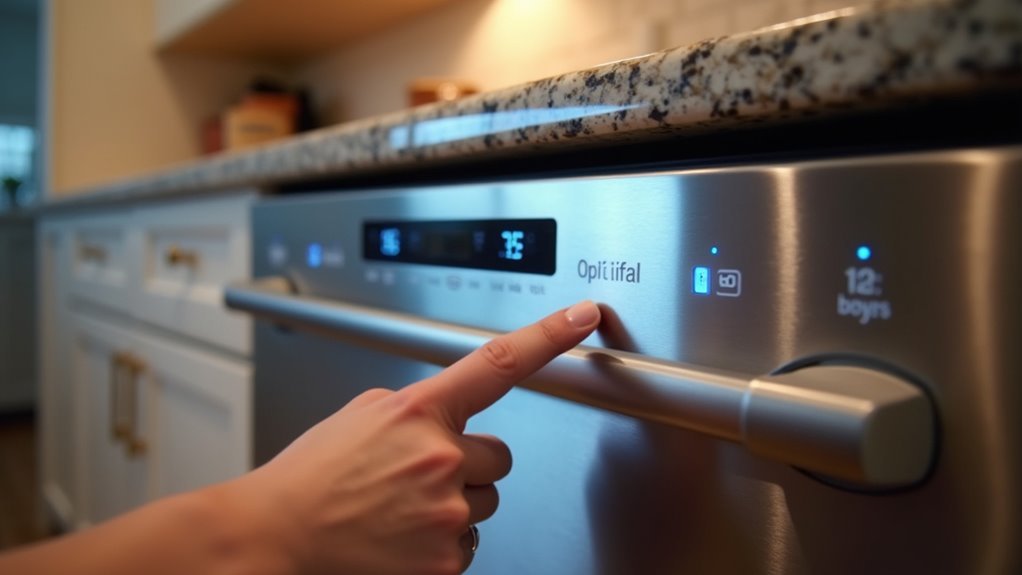


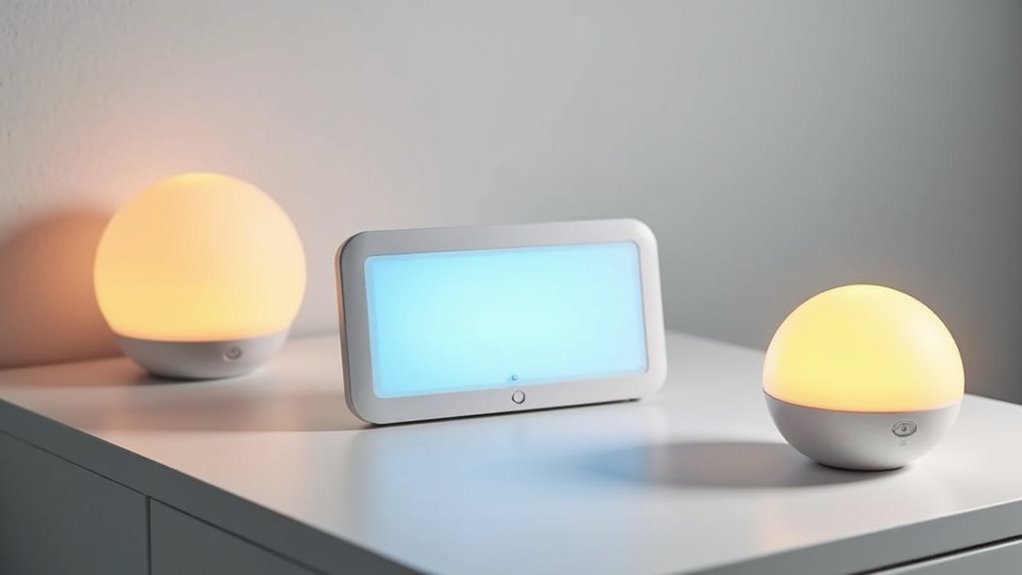
Leave a Reply